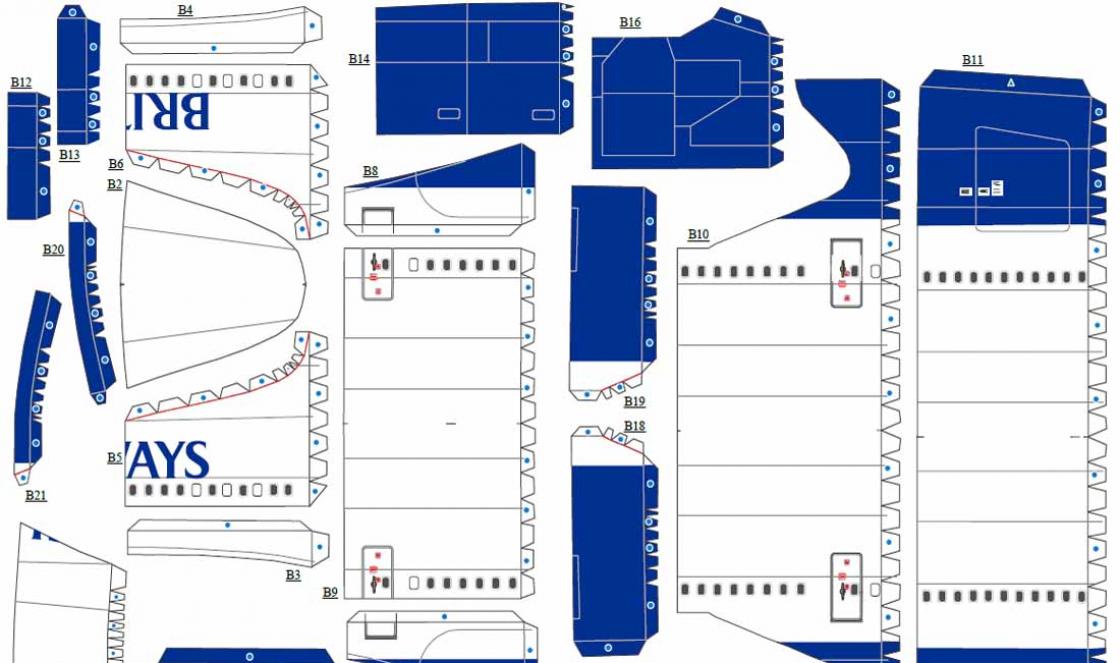Severe or moderate pain in the chin area appear for various reasons. You can get rid of painful sensations by having information about the source of their origin.
There are more than a dozen different pathologies in which a person has pain under the chin. At the same time, the same symptoms can indicate completely different diseases. Therefore, finding out the causes of pain in the lower jaw and treatment must be trusted to professionals.
The nature of pain under the chin
Pain in the chin area can vary in intensity, time and duration of manifestation. The nature of painful sensations varies from strong to moderate and weak. The pain may be constant or appear at certain hours of the day.
Intensity and character discomfort is not an indicator of the danger of the pathological process. Sometimes a slight pain that occurs only when pressed indicates a serious illness. But unbearable, throbbing pains spreading to part of the face can be a symptom neurological pathology, which does not carry a mortal threat.
Causes of pain under the chin
Pain in any part of the body always makes a person think about the source of its origin and take action. The causes of pain under the lower jaw are rarely associated with minor problems. It is important to pay attention to alarming symptoms in a timely manner and seek medical help.
Dental diseases
As a rule, it hurts in the chin area with dental diseases. Pain is a symptom:
- caries;
- pulpitis;
- periodontitis.
A tooth affected by caries allows pathogenic bacteria to penetrate into the jaw, which provokes the appearance of aching or acute pain, contributes to the formation of a purulent focus. Sometimes the increased sensitivity of the teeth becomes a real test for a person. Everything is aggravated when there is a mechanical load, low or high temperature.
Sialolithiasis, or salivary stone disease, can cause pain and swelling under the chin or behind the ears. The formed stones in the salivary glands periodically block the ducts. This leads to an increase in the gland and provokes the formation of purulent foci.
Traumatic injuries
The leading symptom of all traumatic injuries is pain. The intensity of pain indicates the location of the injury and its severity. It should be noted that pain under the chin can begin after a short period of time.

A bruise is one of the easiest types of injury. In this case, only soft tissues are affected, and the bones remain intact. Edema, hematoma (bruise) are observed. Exclusion of the likelihood of serious damage becomes possible after an x-ray examination.
A jaw fracture is characterized by intense pain symptom. When trying to move the lower jaw, the pain becomes unbearable. Such an injury requires special treatment. In severe cases resort to surgical intervention.
The consequences of any injury can remind of themselves for a long time. This is due to the consequences of damage to bones, nerve fibers. The area under the jaw hurts after months and years when the weather changes, after intense mechanical stress.
Inflammatory and infectious pathologies
The cause of pain under the lower jaw can be purulent, inflammatory and infectious pathologies. Diseases are accompanied elevated temperature, intoxication, severe edema.
Osteomyelitis appears due to the ingestion of pathogenic bacteria into the bones. Osteomyelitis is often caused by caries or trauma. The disease poses a serious danger and requires immediate treatment.
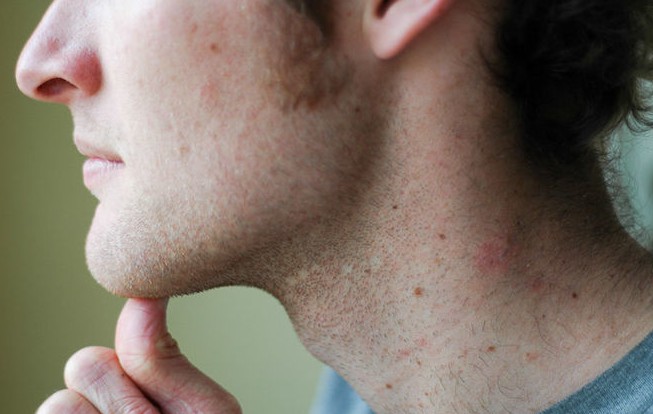
Abscesses, phlegmons, boils can be located in soft tissues lower jaw. AT initial stage disease, pain is felt only when pressed. Sometimes a solid object is felt, increasing in size. Subsequently, soreness can spread to the entire jaw or part of the face.
Infectious diseases, tumor processes can cause an increase in the lymph nodes located under the lower jaw. In this case, soreness under the chin can be observed, especially when pressed.
Pain in neoplasms
Benign and malignant neoplasms can cause pain under the lower jaw. Benign tumors (osteoid osteoma, adamantinoma, osteoblastoclastoma) are almost asymptomatic at first. Subsequently, a person may feel severe pain.
The cause of pain under the chin can be malignant tumors that have formed both in the lower jaw area and in other parts of the body. Metastases, cancer and sarcoma are life-threatening conditions that require immediate treatment.
Neurological and vascular diseases
Neuralgia of the trigeminal, superior laryngeal, glossopharyngeal nerve cause sharp pain in the lower jaw. Nerve damage brings severe suffering, associated with additional symptoms.
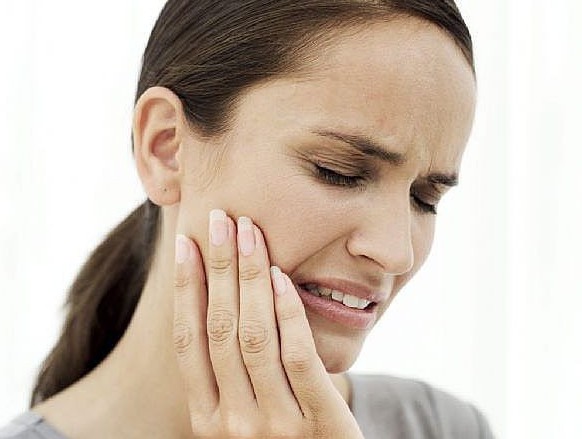
Sometimes the lower jaw hurts due to vascular damage. Arteritis, as well as dysfunction of the vessels of the heart, are accompanied by pain in the chin area. Sometimes the first signs of angina pectoris and myocardial infarction are pain in the lower jaw.
When the pain is not related to the disease
Sometimes soreness under the chin is not associated with a pathological process. Pain in the lower jaw is normal when wearing braces, dentures, caps and other orthodontic structures. This is due to the fact that the devices move the teeth and change the habitual bite.
An orthodontist, who installs corrective structures, must definitely warn a person about a possible pain syndrome. The pain disappears after a short period of time, when a normal bite is formed and the position of the teeth changes.
Treatment for pain under the chin
To get rid of an unpleasant symptom, it is necessary to find out the causes of its occurrence. It is possible to overcome pain if the treatment is aimed at eliminating the disease itself, and not its consequences.
Therapy of conditions accompanied by pain in the chin area should be carried out after a detailed medical examination and diagnosis. Self-management of pain with medicines or folk remedies gives only temporary relief and makes it difficult to find out the reasons. An unprofessional approach in this matter only exacerbates the problem.
We recommend reading related articles:IT'S IMPORTANT TO KNOW:Pain and crunching in the joints over time can lead to dire consequences - local or complete limitation of movement in the joint up to disability. People, taught by bitter experience, use a natural remedy recommended by Professor Bubnovsky to cure joints...
Severe or moderate pain in the chin area appear for various reasons. You can get rid of painful sensations by having information about the source of their origin.
There are more than a dozen different pathologies in which a person has pain under the chin. At the same time, the same symptoms can indicate completely different diseases. Therefore, finding out the causes of pain in the lower jaw and treatment must be trusted to professionals.
The nature of pain under the chin
Pain in the chin area can vary in intensity, time and duration of manifestation. The nature of painful sensations varies from strong to moderate and weak. The pain may be constant or appear at certain hours of the day.
The intensity and nature of discomfort is not an indicator of the danger of the pathological process. Sometimes a slight pain that occurs only when pressed indicates a serious illness. But unbearable, throbbing pains spreading to part of the face can be a symptom of a neurological pathology that does not pose a mortal threat.
Causes of pain under the chin
Pain in any part of the body always makes a person think about the source of its origin and take action. The causes of pain under the lower jaw are rarely associated with minor problems. It is important to pay attention to alarming symptoms in a timely manner and seek medical help.
Dental diseases
As a rule, it hurts in the chin area with dental diseases. Pain is a symptom:
- caries;
- pulpitis;
- periodontitis.
A tooth affected by caries allows pathogenic bacteria to penetrate into the jaw, which provokes the appearance of aching or acute pain, contributes to the formation of a purulent focus. Sometimes the increased sensitivity of the teeth becomes a real test for a person. Everything is aggravated when there is a mechanical load, low or high temperature.
Sialolithiasis, or salivary stone disease, can cause pain and swelling under the chin or behind the ears. The formed stones in the salivary glands periodically block the ducts. This leads to an increase in the gland and provokes the formation of purulent foci.
Traumatic injuries
The leading symptom of all traumatic injuries is pain. The intensity of pain indicates the location of the injury and its severity. It should be noted that pain under the chin can begin after a short period of time.

A bruise is one of the easiest types of injury. In this case, only soft tissues are affected, and the bones remain intact. Edema, hematoma (bruise) are observed. Exclusion of the likelihood of serious damage becomes possible after an x-ray examination.
A jaw fracture is characterized by intense pain symptom. When trying to move the lower jaw, the pain becomes unbearable. Such an injury requires special treatment. In severe cases resort to surgical intervention.
The consequences of any injury can remind of themselves for a long time. This is due to the consequences of damage to bones, nerve fibers. The area under the jaw hurts after months and years when the weather changes, after intense mechanical stress.
Inflammatory and infectious pathologies
The cause of pain under the lower jaw can be purulent, inflammatory and infectious pathologies. Diseases are accompanied by fever, intoxication, severe edema.
Osteomyelitis appears due to the ingestion of pathogenic bacteria into the bones. Osteomyelitis is often caused by caries or trauma. The disease poses a serious danger and requires immediate treatment.
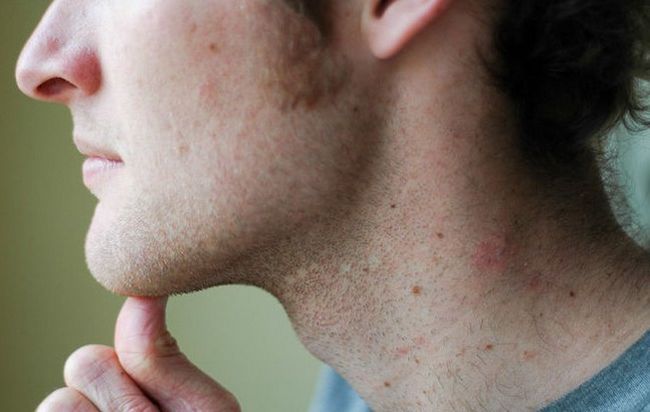
Abscesses, phlegmon, boils can be located in the soft tissues of the lower jaw. In the initial stage of the disease, pain is felt only when pressed. Sometimes a solid object is felt, increasing in size. Subsequently, soreness can spread to the entire jaw or part of the face.
Infectious diseases, tumor processes can cause an increase in the lymph nodes located under the lower jaw. In this case, soreness under the chin can be observed, especially when pressed.
Pain in neoplasms
Benign and malignant neoplasms can cause pain under the lower jaw. Benign tumors (osteoid osteoma, adamantinoma, osteoblastoclastoma) are almost asymptomatic at first. Subsequently, a person may feel severe pain.
The cause of pain under the chin can be malignant tumors that have formed both in the lower jaw area and in other parts of the body. Metastases, cancer and sarcoma are life-threatening conditions that require immediate treatment.
Neurological and vascular diseases
Neuralgia of the trigeminal, superior laryngeal, glossopharyngeal nerve cause sharp pain in the lower jaw. Nerve damage brings severe suffering, associated with additional symptoms.
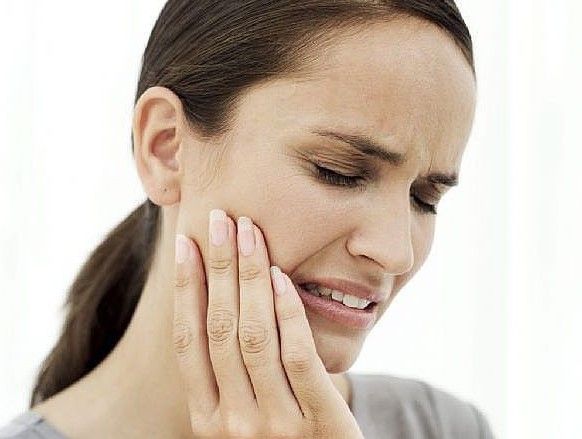
Sometimes the lower jaw hurts due to vascular damage. Arteritis, as well as dysfunction of the vessels of the heart, are accompanied by pain in the chin area. Sometimes the first signs of angina pectoris and myocardial infarction are pain in the lower jaw.
When the pain is not related to the disease
Sometimes soreness under the chin is not associated with a pathological process. Pain in the lower jaw is normal when wearing braces, dentures, caps and other orthodontic structures. This is due to the fact that the devices move the teeth and change the habitual bite.
An orthodontist, who installs corrective structures, must definitely warn a person about a possible pain syndrome. The pain disappears after a short period of time, when a normal bite is formed and the position of the teeth changes.
Treatment for pain under the chin
To get rid of an unpleasant symptom, it is necessary to find out the causes of its occurrence. It is possible to overcome pain if the treatment is aimed at eliminating the disease itself, and not its consequences.
Therapy of conditions accompanied by pain in the chin area should be carried out after a detailed medical examination and diagnosis. Self-elimination of pain with the help of drugs or folk remedies gives only temporary relief and makes it difficult to find out the causes. An unprofessional approach in this matter only exacerbates the problem.
Lymph nodes every second protect the human body from pathogens. Constantly filtering useful substances from harmful ones, they immediately respond to changes in the state of the body.
When a danger occurs, the operation of the system is enhanced, the state of the node changes. If the lymph node on the neck hurts on the right under the jaw or on the left, this indicates the active work of the lymphatic system.
For get well soon it will be useful to help her, which means you need to figure out what process in the body caused such a reaction of the lymph node.
Lymph nodes are located throughout the human body. They unite in groups and take on the function of protecting surrounding tissues and organs.
If the lymph nodes under the jaw hurt, then the pathological process that requires attention takes place in the tissues subordinate to this group of nodes.
Important: the largest number of lymph nodes is based near the facial region, cervical zone, in the armpits and groin, which means that it is in these parts of the body that the infection most often tries to penetrate into the body.
The submandibular lymph nodes receive lymph from the mouth and lower face. From the lymph node, the lymph is already cleared of potentially dangerous particles. The photos and videos in this article will explain the location of the submandibular lymph nodes.
Causes of pain
The causes of complaints about the condition of the lymph nodes are varied. For successful treatment, a doctor must understand them.
Cause - diseases of the ENT organs
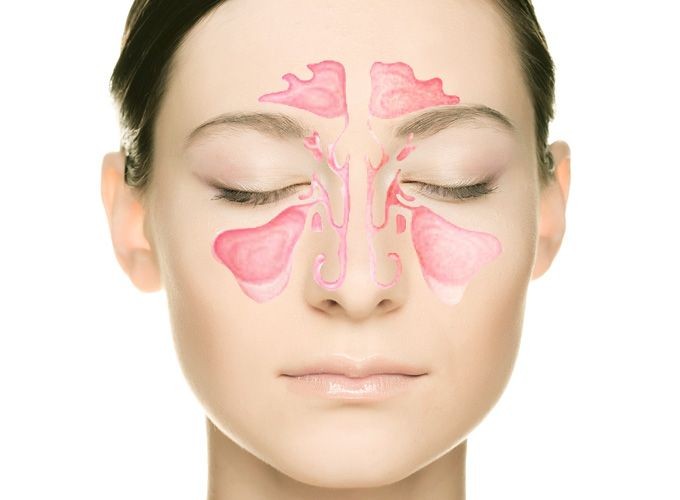
The most common reason that the submandibular lymph nodes hurt is colds and infections of the tissues of the pharynx. So the soreness of the nodes can occur due to the onset of rhinitis or laryngitis.
The cause may be tonsillitis, which has a more severe course. The cause of concern may be inflammation of the maxillary sinuses.
Reason: Infectious diseases
Children may begin to complain that the submandibular lymph node hurts when diseases such as:
- piggy;
- measles;
- chickenpox.
Important: in case of childhood ailments, you should immediately call a doctor at home, self-medicate - expose the child to serious danger.
Cause - dental problems
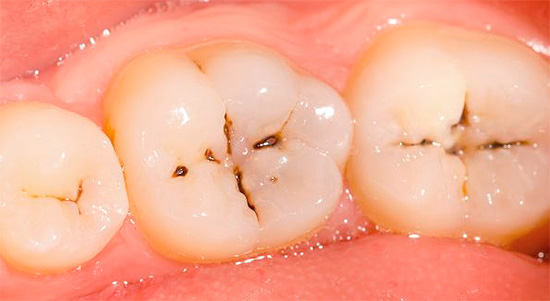
Caries, which is not treated for a long time, causes increased reproduction of pathogens. They enter the lymph node with the flow of lymph and provoke a change in its state.
A more serious case is pulpitis, because the focus of infection in this case is much larger, which means that the lymph nodes can react more actively. Inflammatory processes of the gums can also be the reason that the lymph node on the neck hurts on the left under the jaw or on the right.
Cause - oral disease
With lesions of the oral mucosa - stomatitis, changes in the lymph nodes are inevitable. After all, this disease is severe, with intoxication and high temperature body.
The lymph node under the jaw hurts with abscesses of the soft membranes of the oral cavity, rich in fiber. The sublingual space is especially susceptible to purulent lesions. Inflammation of the salivary glands also causes a reverse response in the body's defense systems.
Cause: Trauma
Head and face injuries are quite common. In this case, the blow may fall in the region of the submandibular zone or neck.
If a person has a complaint that the submandibular lymph node hurts on the left or right, he should remember if there were any force impacts in this area. If there was an episode of impact in the area of the submandibular lymph nodes, you should definitely tell the doctor about it.
Cause - tumor formations
If any formation occurs in the tissues near the lymph node, cells and decay products of the pathological process will inevitably fall into its cavity. This may explain that the submandibular lymph nodes hurt, but are not enlarged.
In most cases, during the first time of the existence of the tumor, the lymph node copes with filtering and destroying dangerous agents. But after a while, the protection weakens. From this moment oncological cells begin to accumulate in the node itself.
At some point, there are too many of them, a tumor occurs in the lymph node.
Diseases of the lymphatic system
If the lymph node hurts on the left under the jaw or on the right, this may be due to problems exclusively with the lymphatic system.
The human body is susceptible to drafts, especially in summer. Top part the surface of the back, neck and submandibular area catches a cold easily, as a result - soreness and stiffness in movements.
Immunodeficiencies, lupus, and other problems may begin with this symptom.
In order to prevent the development of a serious illness that is difficult to treat and difficult to control in the later stages, you should consult a doctor when the first complaints occur. Treatment is carried out strictly under the supervision of a specialist, the instructions and all appointments are followed.
The reason is medication
If pain in the lymph node under the jaw appears with the start of taking any drugs, this is the cause of pain. So some types of hormonal drugs and vaccines can cause changes in the functioning of the lymphatic system.
Important: no matter what, according to the patient, the cause of the complaints, if the lymph node under the jaw hurts, you should definitely visit a specialist, for a start a general practitioner will do.
Symptoms requiring special attention
Along with the fact that the left lymph node under the jaw or the right one hurts, there may be other symptoms of problems with the node:
- temperature rise;
- night sleep disturbance;
- nervousness of the patient and increased sensitivity;
- loss of appetite, nausea;
- increased fatigue, general lethargy;
- sweating, especially at night;
- an increase in the lymph node, so a very serious indicator - the node reaches a size of 1-1.5 centimeters.
Even one of these symptoms indicates that the body's defense mechanisms cannot cope with the infection on their own. In order to prevent the total spread of infection, you need to call a doctor at home and start treatment.
Causes of pain under the jaw:
1. Fractures of the lower jaw. As a result of a strong blow to the face, an accident can result in a fracture of the upper or lower jaw. The consequence of a severe head injury may be a fracture of the upper and lower jaws at the same time.
A jaw fracture is a violation of the integrity of the jawbone under the influence of mechanical stress.
Fractures can be direct and reflected, single and multiple, with and without displacement of bone fragments, open and closed, comminuted.
For fractures of the lower jaw, the characters are such signs as pain under the jaw, hemorrhage, swelling of the soft tissues of the face, impaired chewing function.
2. Osteomyelitis of the jaws is an infectious inflammatory process that affects all elements of the jawbone. Distinguish osteomyelitis hematogenous, traumatic and odontogenic (the most common variety).
The cause of odontogenic osteomyelitis is the microflora of the root canals of the teeth and periodontal pockets (streptococci, staphylococcus, anaerobes).
In acute osteomyelitis, spontaneous throbbing pain under the jaw, headache, chills, temperature up to 40 ° C are observed. An affected tooth is found with a necrotic pulp (possibly with a filling); he and adjacent teeth are sharply painful, mobile. Puffy asymmetrical face. The transitional fold is hyperemic and smoothed. Lymph nodes are enlarged, painful. Osteomyelitis is often complicated by abscess, phlegmon. In the blood, neutrophilic leukocytosis; ESR increased. General condition of varying severity.
3. Dysfunction of the temporomandibular joint causes pain not only in the joint area (in front of the ear), but also in the forehead, temple, under the lower jaw, cheek. It is accompanied by clicking or limitation of movement in the joint. Pain is associated with myofascial syndrome in the masticatory muscles, abnormal bite, inflammatory or degenerative changes in the joint. Examination reveals local tenderness, crepitus when opening the mouth, abnormal position of the articular surfaces, and limited movement of the mandible.
4. Cranial neuralgia is the result of sharp and very strong impulses from the affected cranial nerves. The most common is trigeminal neuralgia. It is characterized by unilateral sudden attacks of acute, jerking, burning, cutting pain in the zone of innervation of one or more branches of the trigeminal nerve. Pain rarely occurs at night and is never felt behind the ear and in the lower part of the mandible.
5. Neuralgia of the superior laryngeal nerve is characterized by paroxysmal unilateral or bilateral pain in the larynx (usually at the level of the upper part of the thyroid cartilage or hyoid bone) and the angle of the lower jaw, radiating to the eye, ear, chest and shoulder girdle and accompanied by hiccups, hypersalivation, cough. Pain is provoked by swallowing, yawning, coughing, blowing your nose, head movements. Carbamazepine (Finlepsin) and local anesthesia in the zone of the hyothyroid membrane are effective. In resistant cases resort to the intersection of the nerve.
6. Neuralgia of the glossopharyngeal nerve is extremely rare. It is manifested by paroxysmal pain, which usually starts from the root of the tongue or tonsil and spreads to the pharynx, ear, under the angle of the jaw, sometimes radiates to the eyeball, less often to the neck. Pain attacks occur suddenly with movements of the tongue or pharynx, while talking or eating (swallowing), last from 1 to 3 minutes, always one-sided, shooting, burning. During an attack, dry mouth, dry cough, and after it - increased salivation are often noted. Characteristic posture of patients with a tilt of the head in the direction of pain, pain on palpation of the point behind the corner of the lower jaw
7. Neuralgia of the ear node is manifested by burning paroxysmal pains (an attack lasts up to 1 hour) in the temporal region in front of the external auditory canal, often radiating to the lower jaw, chin, sometimes teeth. The pain attack is accompanied by hypersalivation and clicking sounds in the ear (the symptom is caused by periodic spasms of the auditory tube caused by contraction of the muscle that strains the auditory tube, which is innervated by the fibers of the ear node) on the side of the pathological process. Pain can provoke the intake of hot or cold food, hypothermia of the face. Characterized by pain when pressing on the point between the external auditory canal and the TMJ.
8. In case of damage (arteritis) of the facial artery, the pain is burning in nature, begins in the lower region (from the chin to the angle of the lower jaw) or upper (in the region upper lip, wings of the nose or nasolabial folds) of the jaw. The end point of pain irradiation is the medial corner of the eye. A typical symptom is the presence of soreness at the site of the inflection of the facial artery through the base of the lower jaw.
9. Carotidinia is characterized by attacks of pain lasting several hours and localized in the upper neck, face, ear, under the lower jaw, teeth. This pain can be provoked by palpation of the common carotid artery near the bifurcation. In most cases, carotidinia appears to be a variant of migraine. Sometimes similar symptoms occur with temporal arteritis, dissection of the carotid artery, or its displacement by a tumor.
10. Odontogenic pain. Pain in the region of the upper and lower jaw often occurs due to irritation of the nerves during caries, diseases of the dental pulp, periodontal abscesses. It intensifies at night, has a pulsating character and is often accompanied by local pain in the region of the root of the tooth. Sometimes chronic facial pain is caused by limited osteomyelitis of the jaw with the formation of microabscesses. After tooth extraction or dental operations, trigeminal neuropathy may occur, manifested by a decrease in sensitivity in the lower lip, weakness of the masticatory muscles.
11. Osteogenic sarcoma accounts for 22% of malignant non-epithelial tumors of the jaws. It can be manifested by deformation of the affected bone, facial pain, moderate pain on palpation. Sometimes, before the onset of pain, numbness occurs, a violation of sensitivity in the area of \u200b\u200bthe exit of the infraorbital or chin nerves.
12. Erythrootalgia (red ear syndrome) is characterized by intense burning pain in the ear, sometimes radiating to the forehead, occiput, lower jaw, accompanied by redness and fever of the auricle (due to expansion of skin vessels). The cause of the syndrome can be cervical spondylosis, accompanied by irritation of the third cervical root, dysfunction of the temporomandibular joint, atypical neuralgia of the glossopharyngeal nerve, damage to the thalamus, idiopathic hypersensitivity of pain fibers to heat.
If there is soreness and swelling of the lymph nodes under the jaw, then you should consult a doctor, as this may be a symptom of cancer.
Lymph nodes are the guardians of our immunity, which are involved in the elimination of a pathogenic agent that has entered our body. Therefore, any disease associated with an infectious process or malignant degeneration of cells will be accompanied by signs of involvement of the lymph nodes. If the lymph node on the neck on the right under the jaw hurts, then this indicates an inflammatory or tumor process in this area.
Lymph flows into the submandibular lymph nodes from such atomic structures as the teeth of the upper and lower rows, lips, buccal region, floor of the mouth, salivary glands, eyelids, hard and soft palate, palatine tonsils, tongue, nose. Therefore, the pathological process of these formations will lead to changes in the lymph nodes on the neck under the lower jaw. The following reasons may lead to this.
Dental problems
Caries leads to the gradual destruction of enamel and other structural elements of the tooth. Without natural protection, teeth become vulnerable to bacteria, which are abundant in the oral cavity. The penetration of infection through the canals of the tooth causes diseases such as:
- pulpitis;
- periostitis;
- periodontitis;
- radical abscess;
- tooth cyst.
With these pathologies, infectious agents enter the lymphatic vessels, through which they penetrate into the mandibular lymph nodes. Accordingly, if the inflammation process develops on the left, then the lymph nodes under the jaw on the left side will be enlarged and painful, and if on the right, then on the right.
Tonsillitis
Tonsillitis, both acute and chronic, can cause inflammation in the lymph nodes in the neck. At the same time, they will be enlarged both on the right and on the left under the jaw. But this symptom will be relegated to the background by the following signs:
- severe sore throat, especially when swallowing food or drink;
- throat red, swollen;
- body temperature can rise to high numbers (400C);
- purulent plaque on the tonsils.
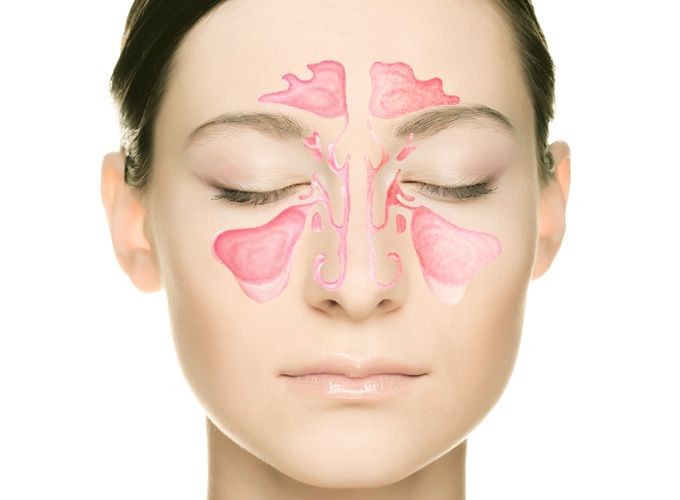
Inflammation of the maxillary sinus will also lead to a pathological process in the lymph nodes under the jaw. This causes the following symptoms:
- the temperature is increased;
- a feeling of fullness, pulsation and heat under the eye;
- sinus pain;
- discharge of mucus and / or pus from the nose.
Infectious parotitis
In the people, this disease is known as mumps. It is characterized by inflammation of the parotid salivary gland, and at the same time, the lymph nodes under the lower jaw are also involved in the process. Such inflammation is manifested by an increase in the parotid region. This is accompanied by some catarrhal phenomena and fever.
festering wounds
If there is a wound, a hematoma in the area of \u200b\u200b"influence" of the lymph node, then it is quite possible to develop purulent process in her. As a result, the lymph node hurts and enlarges.
Tumor processes
Atheroma and lipoma
Atheroma and lipoma are benign tumors, but they can also cause an increase in the lymph nodes under the jaw.
Leukemia
These are tumor diseases of the cells from which white blood cells are formed. There are acute and chronic leukemias, which differ in the differentiation of the cell substrate. Both those and others cause a reaction of the lymph nodes, spleen, liver, which are significantly enlarged.
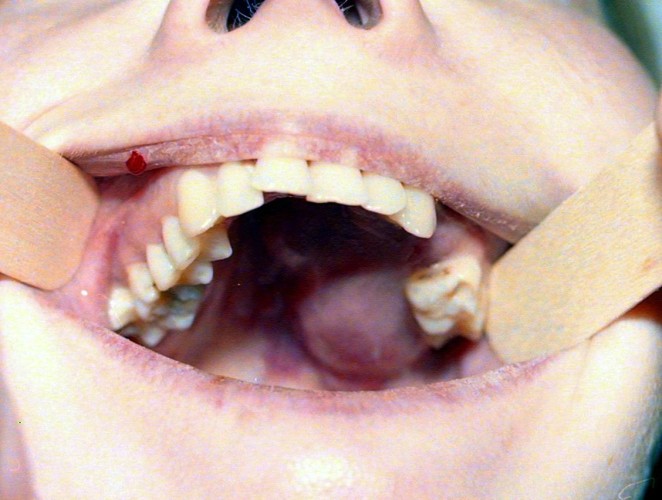
It is most often possible to determine this disease only when the process has already gone far. The thing is that this cancer is mistaken for such dental pathology as gingivitis, stomatitis, tooth loss. In this case, the lymph node under the lower jaw of the corresponding side is enlarged and hurts. For oncological diseases, adhesion of the lymph nodes to the skin and surrounding tissues is characteristic. In addition, the following symptoms are observed:
- toothache in the area of the tumor;
- cheek swelling;
- facial asymmetry;
- lacrimation;
- pain spreads to the temple, forehead.
Lip cancer
Terrible disease, which is most often manifested by long-term non-healing ulcers on the lip, often the lower one. As with cancer of another localization, the lymph nodes are characterized by soreness, enlargement and adhesion to the skin. Also, regular injury, smoking, hereditary predisposition, chemical production will predispose to the development of cancer. It is important to notice precancerous conditions, which include:
- chronic cracks;
- leukoplakia;
- cheilitis Manganotti;
- papillomas;
- dyskeratosis in a warty form;
- erythroplakia;
- lichen planus in an erosive form.
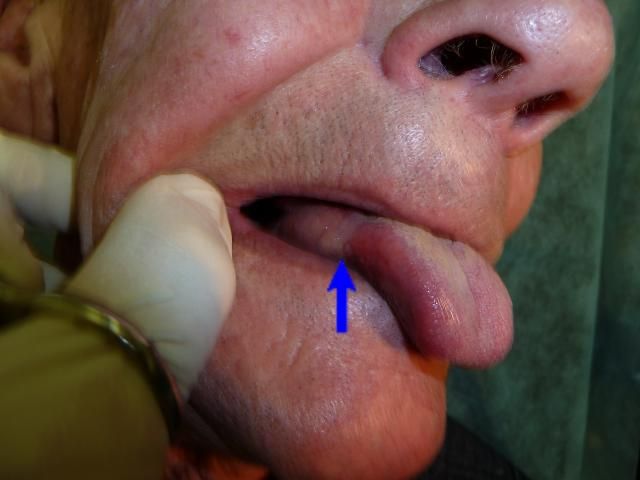
AIDS
This is a pathology of the immune system, in which a person cannot cope with an infection that has entered the body. With this disease, the lymph nodes are totally enlarged.
Autoimmune pathologies
Systemic lupus erythematosus
This is a serious disease of the connective tissue, in which there is an increase in the lymph nodes, including under the jaw. But this is not a specific feature. A characteristic symptom for this pathology is a red spot on the face, resembling a butterfly. With a rapid course, a person can die in 1-2 years. In the chronic form of the course, the insufficiency of organs and systems develops gradually. This affects:
- cardiovascular system in the form of pancarditis;
- kidneys in the form of lupus nephritis;
- liver;
- vessels of the brain, heart muscle;
- hematopoietic system.
Rheumatoid arthritis
The main place of application of this disease are the small joints of the hands, feet. In this case, a characteristic sign is the morning stiffness of movements. Pathognomonic symptoms are also:
- rheumatic connective tissue nodules;
- inflammatory processes of blood vessels (vasculitis);
- inflammation of the serous membranes (pleura, peritoneum, pericardium);
- pneumonia and carditis (inflammation of the heart);
- nerve damage;
- kidney damage (renal failure);
- eye damage, etc.
Lymphadenopathy (enlarged lymph nodes) of the submandibular region is also characteristic rheumatoid arthritis in its highly active form. Along with this symptom, the spleen enlarges and hurts.
As you can see, if the submandibular lymph node is inflamed and sore, the options for pathological processes can be very diverse. This should prompt an urgent trip to the doctor.
We recommend reading related articles:IT'S IMPORTANT TO KNOW:Pain and crunching in the joints over time can lead to dire consequences - local or complete limitation of movement in the joint up to disability. People, taught by bitter experience, use a natural remedy recommended by Professor Bubnovsky to cure joints...




